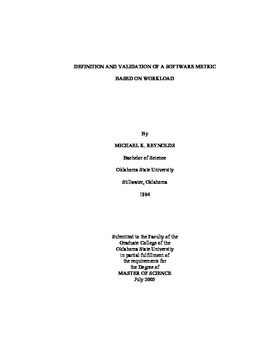| dc.contributor.advisor | Samadzadeh, Mansur H. | |
| dc.contributor.author | Reynolds, Michael Kent | |
| dc.date.accessioned | 2014-04-15T18:33:12Z | |
| dc.date.available | 2014-04-15T18:33:12Z | |
| dc.date.issued | 2005-07-01 | |
| dc.identifier.uri | https://hdl.handle.net/11244/8236 | |
| dc.description.abstract | Software "size" metrics play an important role in the field of measurement in software engineering. Size metrics help to quantify and estimate productivity, overall cost, progress, and process improvement. This thesis was a study to define a size metric based on the "workload" of the programming staff. In this context, the definition of workload is simply the total amount of code worked by the programming staff (code added, modified, and deleted in the implementation of the requirements for a version of a software product). The term "code" includes the source lines and the comment lines as well as the data files and script files required for complete implementation of the system requirements. The new metric, i.e., the Worked Lines of Code (WLOC) metric, was compared to other size metrics that have a good basis in the software industry already. Simple correlation analyses were applied to the data sets generated from four historical versions of a software project to compare the new metric to Source Lines of Code, Function Point Count, and Halstead Token Count. The main objectives of this study were to define a new metric and compare it to a number of popular and established software metrics. Using software analysis tools from various vendors, size numbers were generated for four historical versions of a substantial application program from industry. In particular, data was generated for source lines of code (SLOC), Enhancement Function Point Count, and Halstead Token Count. The data for the metrics were collected from the four historical versions of the application using a count utility designed and implemented to determine the lines of code added, modified, and deleted. The correlation study indicated strong relationships between the new metric and Function Point Count. The study found weak relationships with source lines of code and Halstead Token Count. Based on the data collected, the new metric was deemed a valid size measurement for software projects. | |
| dc.format | application/pdf | |
| dc.language | en_US | |
| dc.publisher | Oklahoma State University | |
| dc.rights | Copyright is held by the author who has granted the Oklahoma State University Library the non-exclusive right to share this material in its institutional repository. Contact Digital Library Services at lib-dls@okstate.edu or 405-744-9161 for the permission policy on the use, reproduction or distribution of this material. | |
| dc.title | Definition And Validation Of A Software Metric Based On Workload | |
| dc.type | text | |
| dc.contributor.committeeMember | Chandler, J. P. | |
| dc.contributor.committeeMember | Mayfield, B. E. | |
| osu.filename | Reynolds_okstate_0664M_1369.pdf | |
| osu.college | Arts and Sciences | |
| osu.accesstype | Open Access | |
| dc.description.department | Computer Science Department | |
| dc.type.genre | Thesis | |
| dc.subject.keywords | software metrics | |
| dc.subject.keywords | software measurement | |
